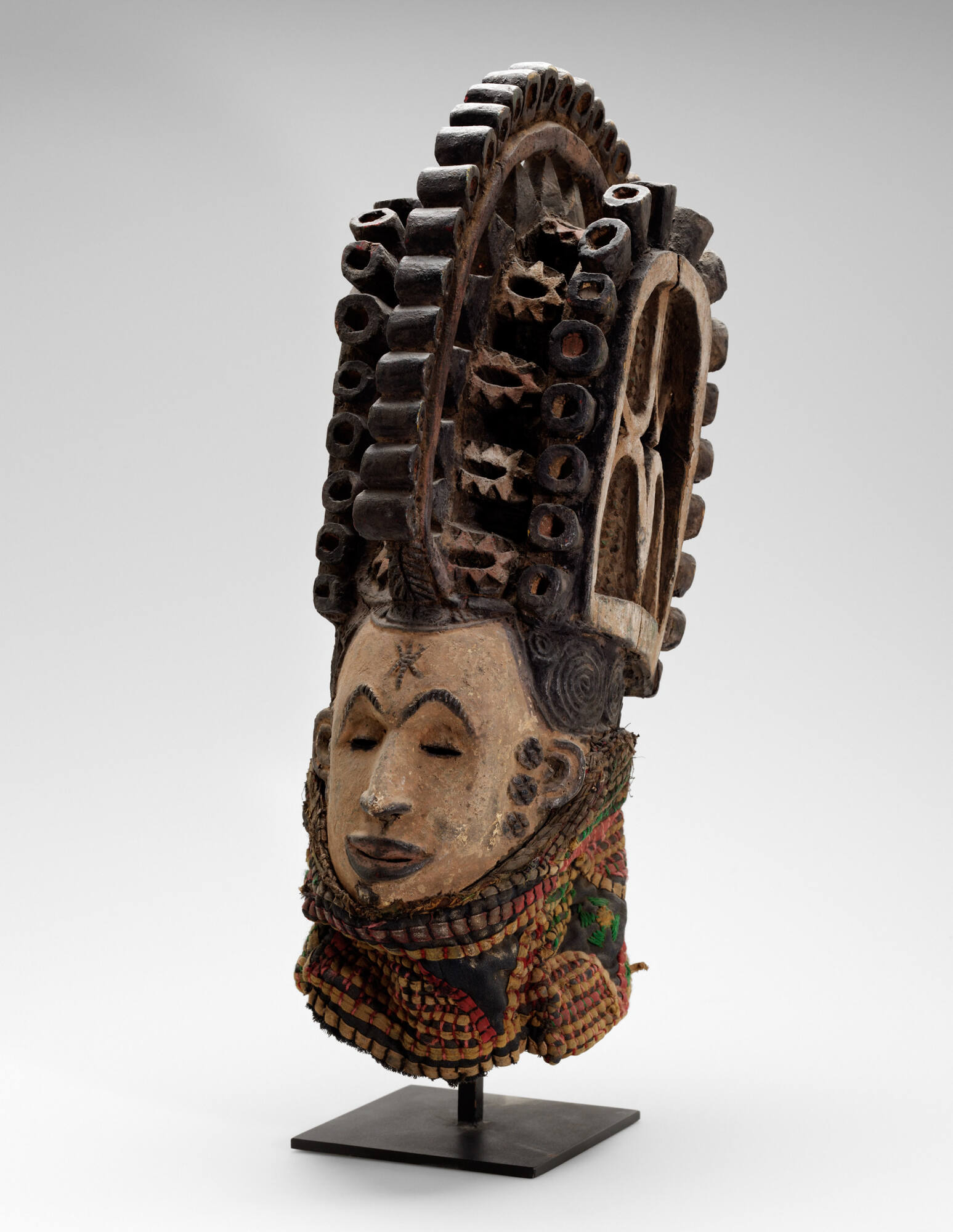
Object Details
Culture
Igbo (Nigeria)
Medium
Wood, woven textiles, and pigment
Dimensions
22 1/2 x 8 x 14 1/2 inches (57.2 x 20.3 x 36.8 cm)
Credit Line
Gift of Dorothy Brill Robbins, Class of 1933
Object
Number
90.057.011
BRIEF DESCRIPTIONThis female spirit mask with elaborate openwork coiffure, scarifications, cloth and(…)
BRIEF DESCRIPTIONThis female spirit mask with elaborate openwork coiffure, scarifications, cloth and pigment, is likely one of several which depict sisters of various ages.WHERE WAS IT MADE?This mask was made in Nigeria, in an Igbo community. The Igbo people, also known as the Ibo people, originate from southeast Nigeria, originally being divided by further cultural sub-groups. Agriculture was and still remains a chief tenant of the Ibo cultureHOW WAS IT MADE?All Igbo masks are carved by men who gain status in the community for their skills and are encouraged to innovate on the maiden mask form within a certain range. Consequently, many masks of the same type illustrate a variety of differing features and artistic styles. Today, many Igbo villages have ceased to commission sculpted wood masks and have switched to using a cane structure covered with cloth and ornamentations.Although a single artist carves the mask, many village members may be involved in the production of the accompanying costume, a tightly fitted fabric bodysuit. (To see an Igbo maiden costume in the Johnson Museum’s collection, search for object number 2002.175.001 in the keyword search box.) Fabric attached to the mask visually connects the mask to the rest of the costume. Snug rather than loosely draped, this portion serves to elongate the appearance of the maiden’s neck. Igbo people admire long, graceful necks. The costume mimics uli body painting in its surface design and often features small, pointed breasts. When performed, the masquerade emphasizes female grace and humility.HOW WAS IT USED?The maiden masquerade embodies Igbo notions of female attractiveness, which combines grace, physical beauty, fertility, and moral behavior. The maskers are young men—few men over the age of twenty-five partake in the masking—and must be athletic, lean, and very graceful in order to mimic female gestures and elegance. They stress maidens’ obedience, generosity, and chastity with highly expressive and rhythmic movements. However, some men exaggerate femininity or dance more vigorously than would most females. Maidens dance on different occasions. When appearing just before the end of the dry season, they help to promote abundant crops; when dancing at prominent funerals, they serve as escorts to the spirit world. The modest size of the coiffure on this mask suggests that it represents one of the younger sisters. In the maiden masquerade, she would follow the eldest sister, called “Headload” (Idu), who leads the group wearing an enormous superstructure that reaches nearly three feet above the masker’s head.Among the Igbo, masquerades are believed to arise from the world of the dead. Masks represent spirits who have left the otherworld and entered the world of the living via anthills. WHY DOES IT LOOK LIKE THIS?Maiden masks embody Igbo notions of female beauty. The maskers represent unmarried girls in an idealized, unattainable form. Notice that the mask depicts fine facial features: a light complexion, smooth skin, high-bridged nose, facial tattoos and stamps, and a refined mouth. Maiden masks have fantastically elaborate coiffures that exaggerate real hairdos. The white skin of the maiden mask represents both physical and moral attractiveness. Light-skinned Igbo women are favored in the community, not because they appear more European, but because fairer skin allows for more conspicuous tattoos, body stamps, and uli body painting. These permanent and temporary body adornments draw public attention to a young woman’s symmetrical features. White skin also implies purity.












